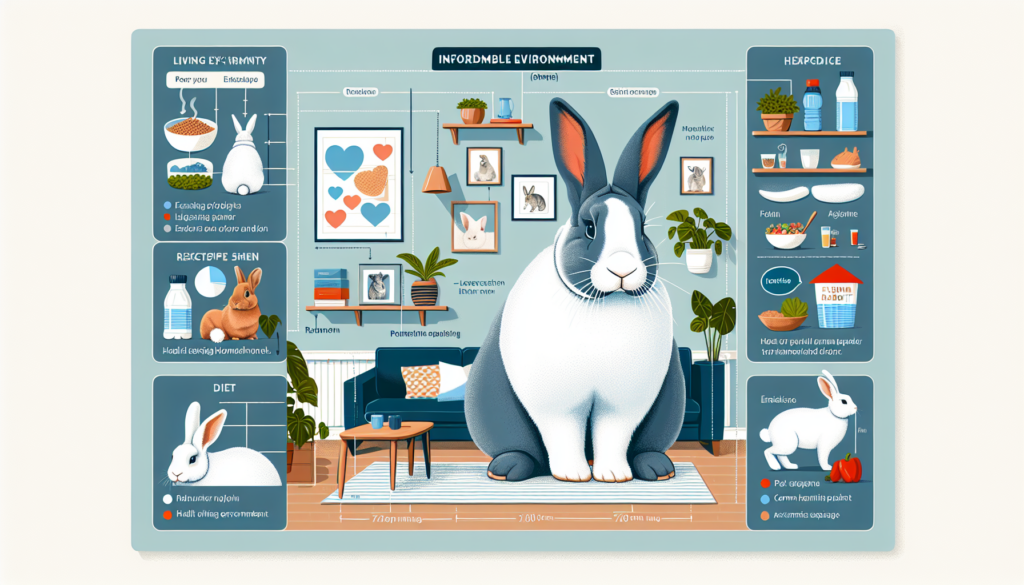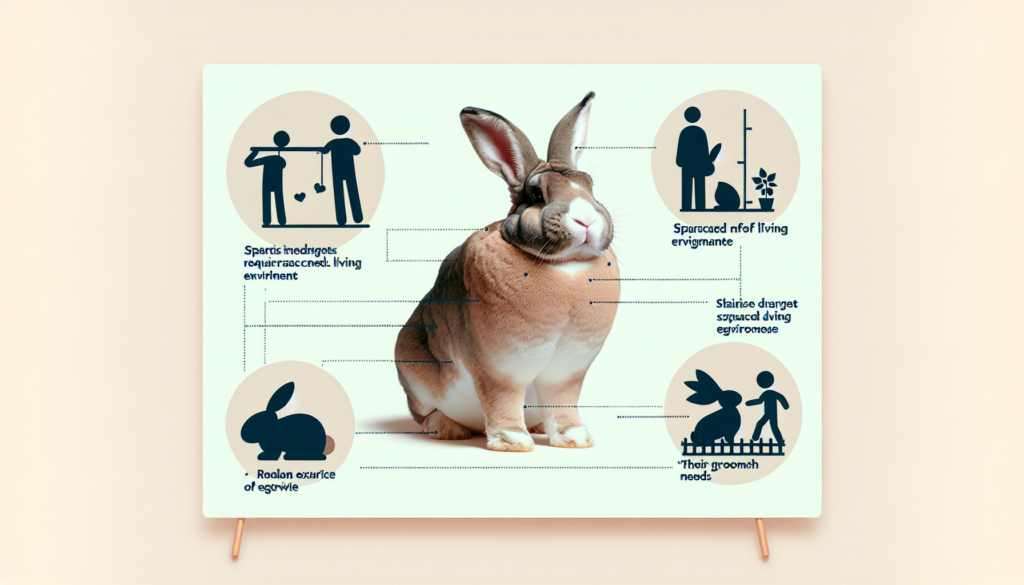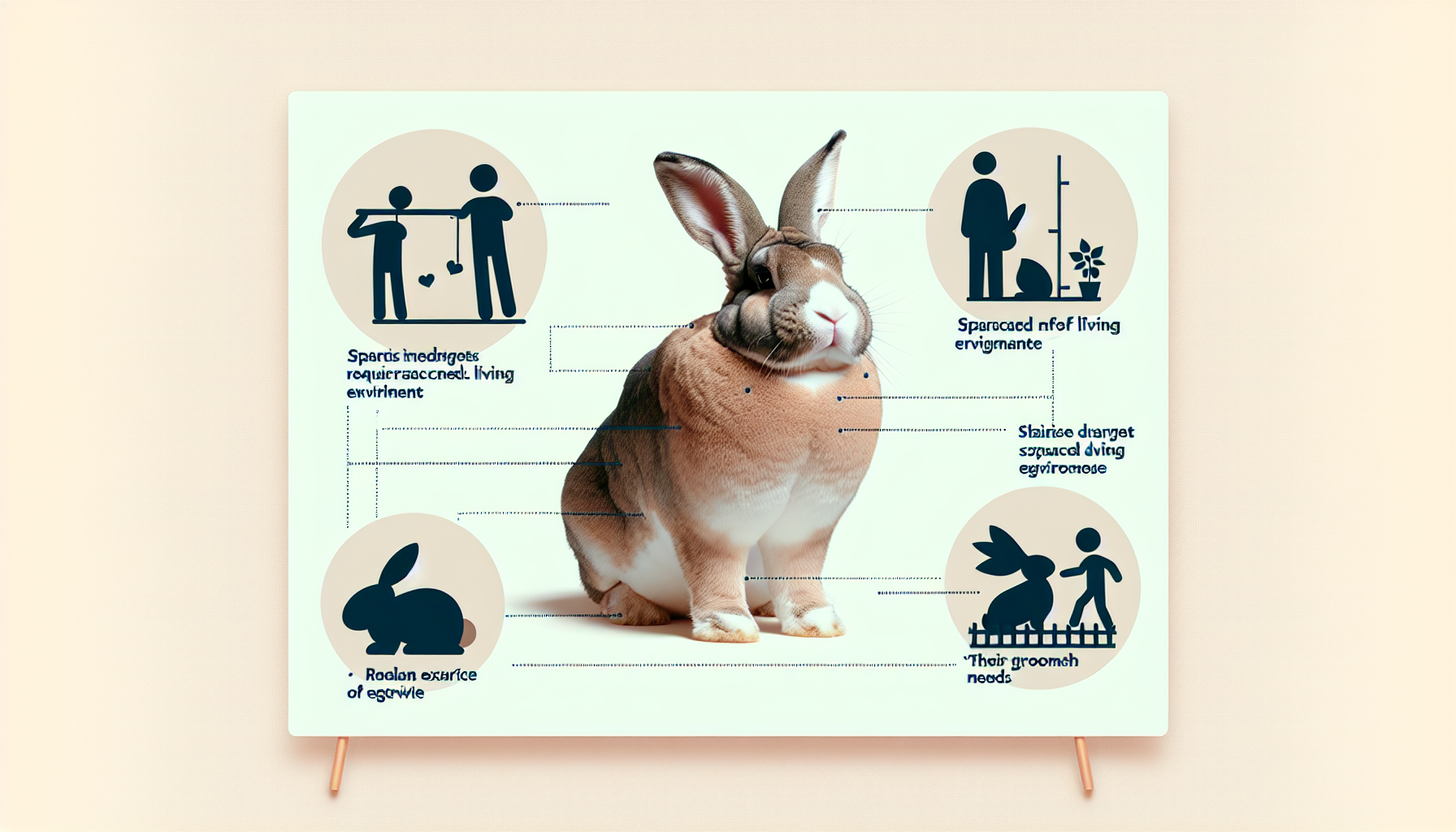Thinking about getting a furry friend to add some joy and companionship to your life? Look no further than the adorable and captivating Flemish Giant Rabbit! Known for their impressive size and gentle nature, these lovable creatures make great pets for families and individuals alike. In this article, we will explore the qualities and requirements of owning a Flemish Giant Rabbit, helping you determine if this charming companion is the perfect fit for you. So, let’s hop right in and discover the wonders of having a Flemish Giant Rabbit as a pet!
About Flemish Giant Rabbits
Origin and history
Flemish Giant Rabbits, as the name suggests, originated in Flanders, Belgium. They were initially bred in the 16th century for their meat and fur. However, their impressive size and gentle temperament soon made them popular as show animals and eventually as beloved pets. Flemish Giant Rabbits made their way to the United States in the early 1900s and have since gained a loyal following for their unique characteristics.
Appearance and size
Flemish Giant Rabbits are known for their remarkable size. They are considered the largest breed of rabbits in the world, with some individuals weighing up to 20 pounds or more. Their robust bodies are muscular and well-rounded, giving them a distinctive presence. These rabbits have a dense, soft coat that comes in a variety of colors, including sandy, steel gray, black, blue, fawn, and white.
Temperament and behavior
Flemish Giant Rabbits have a reputation for being friendly, docile, and sociable pets. They are known for their gentle and affectionate nature, making them suitable for families with children. These rabbits tend to be calm and enjoy human company, often seeking out attention and affection. While their demeanor is generally placid, it is important to note that individual temperaments can vary. Some rabbits may be more reserved or independent, so it’s essential to spend time getting to know your rabbit and cater to their specific needs.
Considerations before Getting a Flemish Giant Rabbit
Space and housing requirements
One of the most crucial factors to consider is whether you have enough space to accommodate a Flemish Giant Rabbit. Due to their large size, they require a spacious living environment to move around comfortably. A hutch or enclosure should provide enough room for the rabbit to stretch, hop, and exercise. Additionally, it’s essential to ensure the enclosure is secure, as Flemish Giant Rabbits are strong and capable of escaping if not properly contained.
Time commitment
Owning a Flemish Giant Rabbit requires a significant time commitment. These rabbits thrive on human interaction and need daily exercise and mental stimulation. They enjoy hopping around and exploring their surroundings, so it’s essential to dedicate time to providing them with playtime and enrichment. Additionally, rabbits are social animals and will benefit from regular interaction and companionship from their owners. Therefore, if you have a busy schedule or are frequently away from home, a Flemish Giant Rabbit may not be the best pet for you.
Costs
Owning a Flemish Giant Rabbit comes with various financial considerations. Firstly, there is the initial cost of purchasing the rabbit, which can vary depending on the breeder, lineage, and rarity of the color. Additionally, there are ongoing expenses such as food, bedding, toys, and regular veterinary check-ups. It’s important to budget for the long-term costs associated with owning a rabbit, including potential emergency medical care or unexpected expenses. Ensure you are financially prepared to provide for the rabbit’s needs throughout its lifetime.
Allergies and health concerns
Before bringing a Flemish Giant Rabbit into your home, it’s essential to consider any allergies or health concerns that may arise. While rabbits are generally hypoallergenic, some individuals may still experience allergies to their fur or dander. It is advisable to spend time with rabbits before committing to ownership to gauge any allergic reactions. Additionally, like any pet, rabbits are susceptible to various health issues, including dental problems, obesity, and infectious diseases. Regular veterinary care and a nutritious diet are essential to maintain their overall well-being.
Compatibility with other pets
If you have other pets in your household, it’s important to consider their compatibility with a Flemish Giant Rabbit. While rabbits can coexist peacefully with certain animals, such as cats or guinea pigs, caution must be exercised when introducing them to other pets. Some animals may view rabbits as prey, while others may exhibit territorial behaviors. Proper introductions, supervision, and ample time for adjustment should be provided to ensure a harmonious and safe living environment for all pets involved.
Caring for a Flemish Giant Rabbit
Feeding and dietary needs
Flemish Giant Rabbits require a diet consisting mainly of hay, fresh vegetables, and a limited amount of high-quality pellets. Hay helps maintain their dental health and provides necessary fiber for their digestive system. Vegetables such as leafy greens, carrots, and herbs can be given in moderation as a supplement to their hay. It’s essential to avoid sugary or starchy foods, as these can lead to obesity and other health issues. Fresh water should always be available, and food should be provided in appropriate quantities to prevent overeating.
Grooming and hygiene
While Flemish Giant Rabbits have a low-maintenance coat, regular grooming is still necessary to keep them clean and comfortable. They should be brushed once or twice a week to prevent matting and remove loose hair. Additionally, their nails should be trimmed regularly, as overgrown nails can cause discomfort or lead to health problems. Ears and eyes should be checked for any signs of infection or discharge, and teeth should be monitored for proper growth and alignment.
Exercise and playtime
Flemish Giant Rabbits are active animals that require regular exercise and mental stimulation. They should be provided with ample space to hop and run freely, either in a secured outdoor area or within a rabbit-proofed room indoors. Additionally, interactive toys and tunnels can be introduced to encourage physical activity and mental engagement. Playtime with their owners, such as gentle petting or supervised exploration, helps strengthen the bond between the rabbit and their caregiver.
Training and socialization
Training a Flemish Giant Rabbit can be a rewarding experience, as they are intelligent animals capable of learning various commands and behaviors. Basic training, such as litter training, can be accomplished through positive reinforcement and consistency. Socialization is also important to ensure a well-adjusted and friendly rabbit. Opportunities for interaction with humans and exposure to different environments should be provided from an early age to prevent fear or aggression.
Healthcare and veterinary visits
Regular veterinary care is crucial for maintaining the health and well-being of a Flemish Giant Rabbit. Find a veterinarian experienced in treating rabbits and schedule routine check-ups to monitor their overall health, dental care, and vaccinations. Additionally, rabbits should be spayed or neutered to prevent certain reproductive health issues and unwanted behaviors. In case of any signs of illness or injury, prompt veterinary attention should be sought to ensure proper diagnosis and treatment.
Pros of Owning a Flemish Giant Rabbit

Affectionate and gentle nature
Flemish Giant Rabbits are known for their loving and gentle nature. They often enjoy being petted, cuddled, and spending time with their owners. Their calm and docile disposition makes them wonderful companions for individuals and families alike.
Ideal for families with children
Due to their patient and tolerant nature, Flemish Giant Rabbits are particularly well-suited for families with children. They are generally not easily startled or prone to aggressive behavior, making them a safe and enjoyable pet for younger family members.
Can be litter trained
Flemish Giant Rabbits are highly intelligent animals and can be successfully litter trained. With patience and consistency, they can learn to use a litter box, making their care and maintenance more manageable and convenient.
Long lifespan
Compared to smaller rabbit breeds, Flemish Giant Rabbits have a longer lifespan, averaging between 8 and 12 years. This provides an opportunity for a lasting bond and many years of companionship with their owners.
Unique and impressive appearance
The size and appearance of Flemish Giant Rabbits make them truly stand out. Their impressive stature and beautiful fur capture the attention of anyone who encounters them. Owning a Flemish Giant Rabbit allows you to appreciate and showcase their distinctiveness.
Cons of Owning a Flemish Giant Rabbit
Requires ample space
Due to their size, Flemish Giant Rabbits require significant space to live comfortably. It’s important to have a dedicated area or enclosure that meets their space requirements and allows for regular exercise and movement.
Potential for aggression
While Flemish Giant Rabbits are generally gentle, there is the potential for aggression, especially if they feel threatened or stressed. It’s crucial to handle them with care and fulfill their socialization needs to prevent any aggressive behaviors.
Expensive to maintain
the cost of owning a Flemish Giant Rabbit can be higher compared to smaller rabbit breeds. Their larger size means they require more food, bedding, and space. Additionally, regular veterinary care and potential unforeseen expenses can contribute to the overall cost of ownership.
May not be suitable for small living spaces
Due to their size and need for ample space, Flemish Giant Rabbits may not be suitable for individuals living in small apartments or houses with limited indoor and outdoor space. It’s important to consider the available living area before bringing a Flemish Giant Rabbit into your home.
Challenging to find appropriate veterinary care
Finding veterinary care experienced in treating rabbits, especially larger breeds like Flemish Giants, can be challenging in some areas. It’s essential to do thorough research and identify reliable and knowledgeable veterinarians before bringing a rabbit into your family.
Selecting a Flemish Giant Rabbit
Choosing a reputable breeder
When looking to add a Flemish Giant Rabbit to your family, it’s important to choose a reputable breeder. A responsible breeder will prioritize the health and well-being of their rabbits, provide appropriate care, and ensure proper genetic standards are met.
Adopting from a rescue or shelter
An alternative to purchasing from a breeder is adopting a Flemish Giant Rabbit from a rescue or shelter. Many rabbits of various breeds are in need of loving homes, and adopting a rescued rabbit can be a rewarding experience.
Assessing the rabbit’s health and temperament
Regardless of whether you choose to purchase or adopt, it’s important to assess the rabbit’s health and temperament before making a decision. Look for signs of good overall health, such as bright eyes, clean fur, and active behavior. Spend time interacting with the rabbit to gauge their temperament and see if it aligns with your expectations.

Considering the rabbit’s age and gender
When selecting a Flemish Giant Rabbit, consider their age and gender. Younger rabbits may require more time and patience for training, while older rabbits may already have established personalities. The gender of the rabbit may also influence their behavior and compatibility with other rabbits or pets in the household.
Understanding the specific needs of individual rabbits
Each Flemish Giant Rabbit, like any other individual, has unique needs and preferences. It’s important to understand and cater to their specific requirements, whether it be dietary preferences, exercise routines, or socialization needs. Developing a strong bond and understanding with your rabbit will contribute to a fulfilling and harmonious relationship.
Creating a Suitable Living Environment
Providing a spacious and secure hutch or enclosure
Flemish Giant Rabbits require ample space to move around and exercise. A hutch or enclosure should be spacious, allowing them to stretch out, hop, and run. It’s essential to ensure the enclosure is secure, with no gaps or openings that may allow the rabbit to escape or predators to enter.
Furnishing with appropriate bedding and litter
The hutch or enclosure should be furnished with suitable bedding to provide comfort and maintain hygiene. Avoid using cedar or pine shavings, as the strong scent can be harmful to rabbits. Instead, opt for rabbit-safe bedding options, such as straw or paper-based bedding. A litter box filled with rabbit-friendly litter can also be provided for litter training purposes.
Offering hiding spots and stimulation
Flemish Giant Rabbits, like all rabbits, appreciate having hiding spots where they can retreat and feel secure. Provide the enclosure with tunnels, boxes, or hideaways that allow the rabbit to hide and rest when desired. Additionally, engaging toys and objects, such as chewing toys and puzzle feeders, can provide mental stimulation and prevent boredom.
Ensuring proper ventilation and temperature
Rabbits are sensitive to extreme temperatures and require a well-ventilated living environment. The hutch or enclosure should have proper airflow to prevent the buildup of heat or humidity. During colder months, additional bedding or a thermal cover can help provide insulation and keep the rabbit warm.
Avoiding hazards and potential dangers in the environment
When setting up the living environment, it’s crucial to ensure the absence of any hazards or potential dangers. Remove toxic plants or substances that the rabbit may encounter. Secure all wires or cables to prevent chewing, which can lead to electrical shock. Additionally, be mindful of any small objects or sharp edges that may pose a risk of injury to the rabbit.
Feeding and Nutrition
Understanding the dietary requirements
Flemish Giant Rabbits require a balanced diet that consists mainly of hay. Hay should make up the majority of their daily food intake and be available at all times. Fresh vegetables, such as leafy greens, can be offered in moderation as a supplement to their hay. High-quality rabbit pellets should also be provided in limited amounts, ensuring they are specifically formulated for rabbits and free of any harmful additives.
Choosing the right food and treats
When selecting rabbit food and treats, it’s important to choose high-quality options that meet their nutritional needs. Avoid foods that are high in sugar, fat, or carbohydrates, as these can lead to obesity and other health issues. Treats, if given, should be small and limited to occasional rewards.
Avoiding harmful or toxic substances
Rabbits are sensitive to many common household substances that can be harmful or poisonous to them. Avoid feeding your Flemish Giant Rabbit foods that are toxic to rabbits, such as chocolate, caffeine, onions, or garlic. Ensure that any plants or flowers within their reach are non-toxic, as certain plants can be toxic if ingested.
Establishing a feeding schedule
Establishing a consistent feeding schedule for your Flemish Giant Rabbit is important to maintain their overall health and prevent overeating. Divide the daily food intake into multiple smaller meals, ensuring a balance of hay, vegetables, and pellets. This helps regulate their digestion and prevents them from becoming overly dependent on treats or snacks.
Monitoring and adjusting the rabbit’s diet
Regular monitoring of your Flemish Giant Rabbit’s weight and overall condition is essential to ensure they are receiving the appropriate nutrition. If the rabbit becomes overweight or underweight, adjustments may need to be made to their diet. Consult with a veterinarian experienced in rabbit care for guidance on proper feeding and any necessary dietary changes.
Grooming and Hygiene
Brushing and managing fur
Flemish Giant Rabbits typically have a dense and soft coat that requires regular brushing to prevent matting and remove loose hair. Use a comb or brush specifically designed for rabbits and gently brush their fur, paying attention to areas prone to matting, such as behind the ears and under the chin. Regular brushing helps maintain their coat’s health and appearance.
Trimming nails
Regular nail trims are necessary for a Flemish Giant Rabbit’s overall comfort and mobility. Long nails can cause discomfort or curl back and injure the rabbit. Use appropriate nail clippers or a nail grinder designed for rabbits and trim the nails carefully, taking care not to cut too close to the quick, as this can cause bleeding.
Cleaning ears and eyes
The ears and eyes of a Flemish Giant Rabbit should be checked regularly for any signs of infection, discharge, or debris. Use a gentle, damp cloth or cotton ball to clean the area around the eyes and gently remove any dirt or discharge. Ears should be inspected and cleaned if necessary, using a veterinarian-recommended ear cleaner and following the instructions provided.
Bathing and overall hygiene
While rabbits are generally clean animals and groom themselves, they rarely need baths. Flemish Giant Rabbits have a natural protective layer on their fur that should not be removed by bathing. If the rabbit’s fur becomes soiled or stained, spot cleaning can be done using a damp cloth or a rabbit-safe dry shampoo. Bathing should only be done if recommended by a veterinarian for specific medical reasons.
Addressing potential health issues
Regular grooming sessions provide an opportunity to inspect your Flemish Giant Rabbit for any potential health issues. Look for signs of skin irritation, wounds, or abnormal behavior. If any concerns arise, consult with a veterinarian experienced in treating rabbits to address the issue promptly and appropriately.
Conclusion
Assessing suitability and commitment is crucial before deciding to bring a Flemish Giant Rabbit into your home. Consider the space and housing requirements, the time and financial commitment involved, and any potential allergies or health concerns. Weigh the pros and cons of owning a Flemish Giant Rabbit, keeping in mind their affectionate nature and suitability for families with children. Ensure you can provide a suitable living environment and the necessary care and attention for your rabbit. By making an informed decision, you can appreciate the unique qualities of Flemish Giant Rabbits and enjoy a fulfilling and rewarding relationship with your furry friend.
